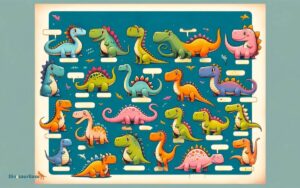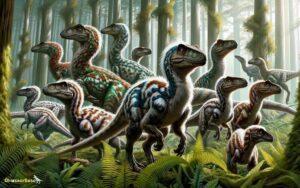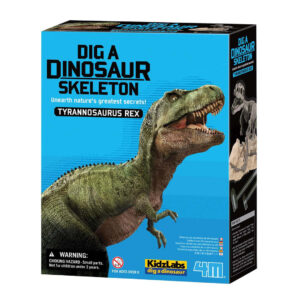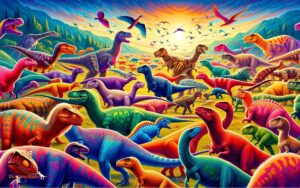When Did Dinosaurs Exist: Unearthing Ancient Secrets
Dinosaurs existed between approximately 230 million and 65 million years ago. This era spanned the late Triassic, Jurassic, and Cretaceous periods.
Dinosaurs, the prehistoric reptiles that once dominated our planet, captivate both the young and the old with their mysterious past. Their reign, extending across three geologic timeframes, marks a period in Earth’s history teeming with diverse and colossal life forms.
These creatures evolved into a multitude of species, ranging from the towering Brachiosaurus to the fierce Tyrannosaurus rex. Their demise, linked to a catastrophic event, paved the way for mammalian expansion and the rise of human civilization. Scientists continue to unravel the secrets of their existence through fossil discoveries, advancing our understanding of life on Earth before human perseverance. The legacy of dinosaurs, deeply embedded in natural history, fuels our curiosity and research, drawing interest from paleontologists and enthusiasts worldwide.
Credit: www.abc.net.au
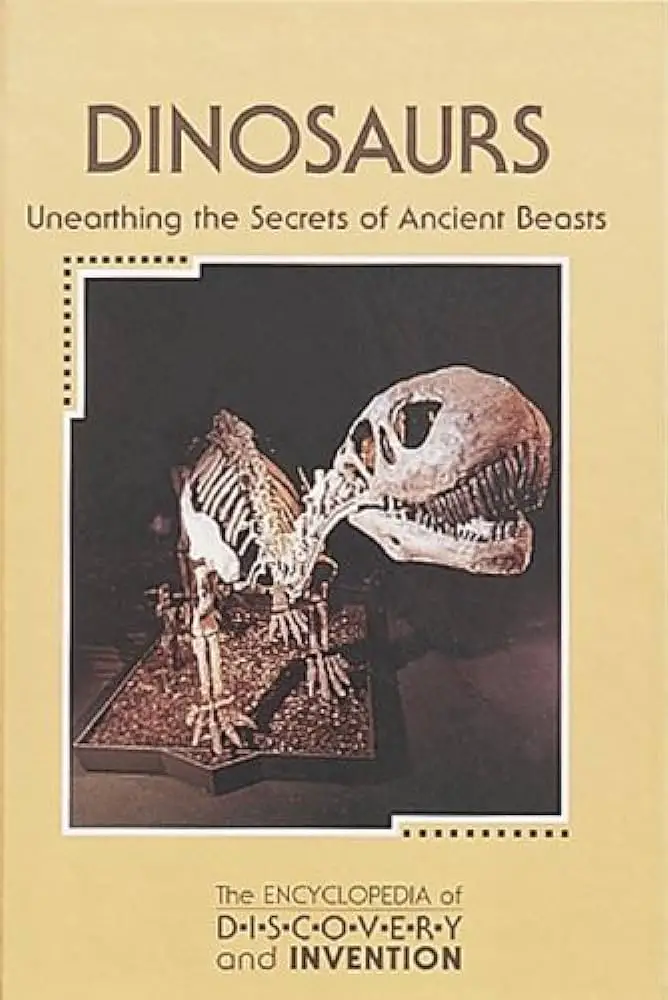
Unveiling The Age Of Dinosaurs
The time when the earth roared with the footsteps of dinosaurs is a tale of epochs. Dinosaurs ruled the planet for over 160 million years. Scientists have pieced together this ancient puzzle using rock layers and fossils. Join us as we travel back in time to discover when dinosaurs existed and the world they inhabited.
The Mesozoic Era: Dawn Of The Dinosaurs
The Mesozoic Era, known as the “Age of Reptiles”, marked the rise of dinosaurs. This era spanned from about 252 to 66 million years ago. It is divided into three periods:
- Triassic: 252 to 201 million years ago
- Jurassic: 201 to 145 million years ago
- Cretaceous: 145 to 66 million years ago
Each period saw different dinosaur species dominate the earth. The Triassic period witnessed the birth of the first recognized dinosaurs. The Jurassic welcomed giants like the Brachiosaurus. The Cretaceous brought us predators such as T. rex and Velociraptor.
Geological Timelines: Deciphering Dinosaur Epochs
Scientists use geological timelines to understand life’s history on Earth. These timelines divide Earth’s history into manageable sections.
| Epoch | Time Range (Million Years Ago) | Dominant Dinosaurs |
|---|---|---|
| Late Triassic | 237–201 | First dinosaurs |
| Early Jurassic | 201–174 | Massive plant-eaters |
| Late Jurassic | 164–145 | Brachiosaurus |
| Early Cretaceous | 145–100 | Feathered dinosaurs |
| Late Cretaceous | 100–66 | T. rex, Velociraptor |
By analyzing rock formations and fossil evidence, paleontologists determine dinosaur existence within these time frames. Each epoch brought forth remarkable changes in climate, sea levels, and life forms on Earth. It’s within these vast timelines that the story of dinosaurs unfurls.
Discovering Dinosaur Fossils
Dinosaur fossils carry the secrets of a world lost to time. They guide us on an adventure millions of years into the past. Dinosaurs ruled Earth during the Mesozoic Era. This era spanned from about 252 to 66 million years ago, across three periods: Triassic, Jurassic, and Cretaceous. Unearthing dinosaur fossils helps us unravel the great mystery of their existence and demise.
Fossil Formation And Burial
Fossils form in a variety of ways. Most dinosaur bones become fossils when buried quickly after the creature’s death. Below are the main steps leading up to the fossilization process:
- A dinosaur dies and its remains settle on the ground.
- Over time, sediment covers the remains.
- Minerals gradually replace the bones or impressions remain in the sediment.
- The sediment layers harden into rock, preserving the shapes as fossils.
This natural wonder turns bones into stone. This keeps them safe from erosion and decay over millennia. It’s a rare event, making each fossil discovery incredibly special.
Pioneering Paleontologists And Historic Finds
Early fossil hunters played a crucial role in paleontology. Their dedication led to groundbreaking discoveries. Here are some notable figures and their contributions:
- Mary Anning – She discovered the first ichthyosaur skeleton in England.
- Richard Owen – He coined the term “dinosaur” in 1842.
- Barnum Brown – Famous for uncovering the first partial skeleton of T. rex in 1902.
These trailblazers built the foundation of our knowledge. The bones and footprints they found tell us stories. They show us how dinosaurs lived, hunted, and evolved over time.
Chronology Of Dinosaur Existence
Dinosaurs roamed the Earth for about 165 million years. This era, known as the Mesozoic Era, spans from around 250 million years ago to 65 million years ago. Scientists break down this era into three distinct periods: the Triassic, Jurassic, and Cretaceous. Each period saw different dinosaur species evolve, thrive, and then become extinct. Let’s embark on a prehistoric journey back in time to understand when dinosaurs once ruled our planet.
Triassic Beginnings: First Dinosaur Ancestors
The Triassic period marks the rise of dinosaur ancestors. It lasted from 250 to 201 million years ago. In this span, the first dinosaurs emerged. They were nimble creatures adapting to a changing world.
- Herrerasaurus: One of the earliest known predators
- Eoraptor: A small, light, and fast creature
- Plateosaurus: An early herbivore that walked on two legs
Jurassic Giants: The Rise Of Iconic Species
The Jurassic period spanned from 201 to 145 million years ago. Dinosaurs grew in size and number. New species evolved with unique adaptations.
- Brachiosaurus: Its long neck reached the highest trees
- Stegosaurus: Its spiked tail served as a potent defense
- Allosaurus: A fierce predator dominated the landscape
Cretaceous Culmination: Diversity And Dominance
The final period, the Cretaceous, lasted from 145 to 65 million years ago. Dinosaurs reached their peak in diversity and complexity.
Dinosaurs like the Triceratops, with its three horns, and the fearsome Tyrannosaurus rex, championed this era. The Cretaceous period ended with a mass extinction, wiping out all dinosaurs.
Extinction Event: The Dinosaurs’ Demise
The fall of the dinosaurs marks one of history’s greatest mysteries. These mighty creatures roamed the earth for about 165 million years. Yet, their long reign came to an abrupt end 65 million years ago. It was a mass extinction event that wiped out over 75% of Earth’s species. Scientists use clues from the Earth’s layers to unravel this puzzle.
The K-t Boundary: Clues To Catastrophe
A critical clue lies within a thin layer of sediment known as the K-T Boundary. This layer marks the moment in time when many species, including dinosaurs, vanished. It holds evidence of an environmental shift. Unique geological features in this layer across the globe suggest a large-scale event occurred.
Asteroids And Volcanoes: Investigating Causes
Scientists have two main theories about what caused this mass extinction. Both theories consider evidence from the K-T Boundary.
- Asteroid Impact: A massive asteroid hit the earth near present-day Mexico. The impact created a huge crater and sent dust and particles into the atmosphere, blocking sunlight.
- Volcanic Activity: In India, the Deccan Traps are expansive volcanic fields. Intense volcanic activity could have released gases and ash that altered the climate.
Researchers continue to uncover more data to understand the exact cause of the dinosaurs’ extinction. Whether it was an asteroid, volcanoes, or a combination of factors, this event forever changed life on Earth.
Dinosaurs In The Modern Imagination
The sheer magnitude of dinosaurs stirs the imagination like nothing else. From museum displays to the silver screen, these prehistoric creatures captivate audiences of all ages. With each new fossil discovery, our understanding deepens, bridging the colossal gap between past and present.
Cultural Impact Of Dinosaur Discoveries
Dinosaurs have left footprints not just in ancient mud, but on modern culture itself. These creatures inspire awe and wonder, influencing various domains:
- Education: Schools use dinosaurs to spark interest in science.
- Art: Artists recreate ancient worlds through illustrations and sculptures.
- Entertainment: Theme parks and movies transport us back in time.
Science Fiction To Science Fact: Dinosaurs In Media
Media plays a pivotal role in shaping our perception of dinosaurs. From books to blockbusters, dinosaurs are depicted in thrilling scenarios:
| Type | Description | Examples |
|---|---|---|
| Literature | Dinosaurs come to life in the pages of books. | Jurassic Park, The Lost World |
| Films | Cinema blends CGI with storytelling. | Jurassic World, The Land Before Time |
| Games | Video games offer interactive dinosaur adventures. | ARK: Survival Evolved, Dino Crisis |
These portrayals transform ancient creatures into prominent figures of popular culture.
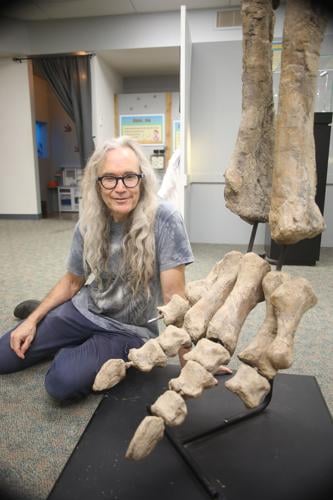
Credit: www.myheraldreview.com

Credit: m.youtube.com
Frequently Asked Questions Of When Did Dinosaurs Exist
When Did Dinosaurs Start And End?
Dinosaurs first appeared around 230 million years ago during the Triassic period. They went extinct approximately 65 million years ago at the end of the Cretaceous period.
When Did Earth First Have Dinosaurs?
Dinosaurs first appeared on Earth approximately 230 million years ago during the Triassic period.
What Does The Bible Say About Dinosaurs?
The Bible does not specifically mention dinosaurs. Its texts predate the term dinosaur, which was coined in the 19th century.
Did Man And Dinosaurs Exist At The Same Time?
No, humans and dinosaurs did not coexist. Dinosaurs became extinct approximately 65 million years ago, while the earliest human ancestors appeared around 6 million years ago.
Conclusion
Dinosaurs roamed the Earth for over 160 million years, dominant in the Mesozoic era. The journey through Triassic, Jurassic, and Cretaceous periods uncovers a time when these magnificent beasts reigned. Unraveling the mysteries of their existence helps us appreciate Earth’s vast history.
Let’s continue exploring, learning, and marveling at the age of dinosaurs.


